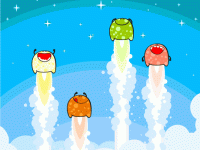Superhero Science
Comic book writers are indebted to scientists, and they demonstrate their gratitude by giving these real life mega-minds special places in the pantheon of superhero mythologies. Bruce Banner, who goes Hulk when angered, developed the Gamma Bomb for the US government. Susan Storm, also known as the Invisible Woman, holds four doctorates in biochemistry and still finds time to save the world. Even the X-Men's Beast is a much-lauded biochemist. Close study of comic book universes and the science concepts upon which they are founded can be enlightening for students and teachers alike. Boys and girls are riveted by the unique powers and compelling personalities and histories of superheroes.
Living Organisms and Superhero Origin Stories
My third grade science students need super-heroic intervention. Fortunately, comic book creators have been experimenting with the structures of living organisms for decades. Consider Spiderman's use of webs to ascend tall buildings, or Dr. Octopus, whose extra appendages were powerful enough to restrain the Incredible Hulk.
Begin this lesson by showing your scholars covers from comic books whose characters borrow their powers from the animal kingdom. I prefer to stick with just an image of the comic book cover unless I know that the comic book is rated appropriate for all ages. You'll find the rating in the lower left or right corner of a comic book. Seeing their favorite superheroes projected onto a screen in an academic setting blows students' minds.
There are dozens of heroes and villains alike who have animal powers, but it's helpful to choose the more familiar characters whose names directly convey their animal abilities for those students who don't read comic books.
Have your students brainstorm what these characters have in common. Once you've established that they are all named for animals, lead students in an analysis of one or two of the characters. Have them identify the characters' powers and describe the source of these powers, based on their widely known origin stories. After a radioactive spider bites him, Spiderman can scale tall buildings because he has the ability to shoot super strong webs from his fingers. Wolverine was born a mutant. Because his skeleton was injected with liquid Adamantium, an indestructible alloy, his sharp claws are unbreakable and he has great strength.
The Making of a Hero
Now tell students that it's their turn to create amazing comic book characters. They'll begin by researching a real life animal with "superpowers." Because my school doesn't have enough computers for each student to do independent research and because I wanted the class to move along at a brisk pace, I laminated cards that provided photos and information about different animals. I chose some familiar animals that have incredible abilities. For example, the flea has the ability to jump 200 times its own height. And the exotic pistol shrimp has mind-boggling powers that would make Superman shake in his red boots. Look it up!
Students analyze these creatures to identify the special abilities they possess and to determine how an animal's structure enables its unique skill. The pistol shrimp's abilities come from its giant claw, the flea's from its powerful back legs.
Once students have identified the abilities of their creatures, give them time to develop a comic book character based on this information. I give students time to write about their superhero, guiding them through details about their characters to include:
- Name
- Origins
- Special powers
- Strengths and weaknesses
- Costume
I also give them comic book cover templates with pre-drawn figures that they can detail and color. It's better if teachers locate these in advance. Comic book figure-related sites sometimes feature distracting versions of the female torso.
Finally we share our heroes as well as information about the creatures who inspired them, and then, just for fun, we pit one character against another and speculate which would be the victor, taking into consideration the strengths and weaknesses of the characters. This isn't a bad time to touch on the concept of natural selection and evolution, prodding students to consider why the creatures may have developed specific abilities that make them super-awesome.
Super Science Teachers
Superheroes come in all shapes and sizes, colors, nationalities and races. They even come from outer space. But nearly all superhero powers were inspired by scientific principles. Sure, comic books have a checkered history in schools. Hiding a comic book behind a textbook is a tradition handed down from generation to generation. For the sake of engagement, it's time we took the comic book out of hiding and reinvented science teachers as super science teachers.
I have included additional third grade science topics and related comic book characters:
- Life Science: Ecosystems -- Understanding how plants survive in their environments:
- Poison Ivy (Batman)
- Krakoa (X-Men)
- Swamp Thing (Swamp Thing)
- Some super plants to consider: poison ivy, Venus flytraps, eucalyptus
- Superman, whose ability to fly is directly linked to gravitational pull
- The Power Pack, four super-charged brothers and sisters with the ability to control aspects of energy, mass, acceleration and gravity. The Power Pack is an excellent resource, appropriate for younger audiences -- topics include bullying, environmentalism and homelessness.
How have you brought superheroes into your science classroom? What sorts of amazing feats have they performed?
